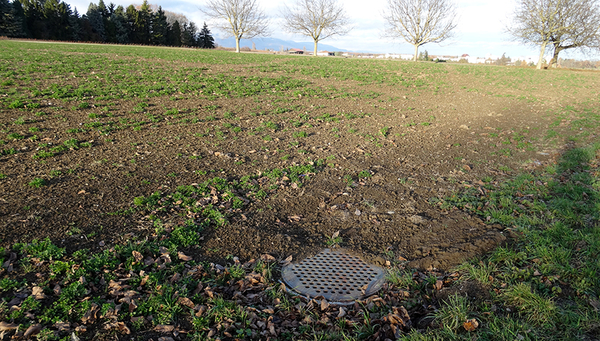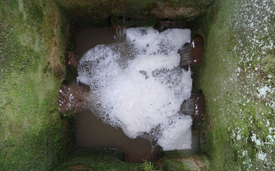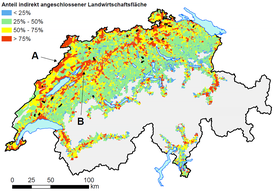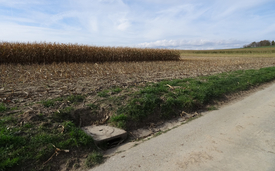Archive detail
Shortcuts lead to greater pesticide contamination
November 3, 2020 |
For their recently published study in the journal Aqua&Gas, researchers examined 20 catchments across the Swiss plateau and the Jura region. With the help of drone images, maps and on-foot inspections, the scientists looked for inlets and maintenance manholes through which water can rapidly enter the nearest stream. They also searched alongside roads and field paths for gullies and drainage ditches that transport collected rainwater directly into the nearest body of water. Experts refer to these features as hydraulic shortcuts, since the water being transported is not purified either in a wastewater treatment plant or by passing through soil.
Here, water from several inlet shafts converges before flowing directly into the nearby stream.
(Photo: Eawag, Urs Schönenberger)
Wide areas affected
On average, for the studied areas of arable land with connectivity to a body of water, 55 percent of the area is connected via shortcuts. Soil hydrologist Christian Stamm, who led the study, therefore concludes that these flow paths are responsible for considerable contamination of streams with plant protection products – especially given that runoff from roads and pathways during rainfall events may contain far higher concentrations of pesticides than was previously assumed.
Percentage of hydraulic shortcuts (= indirect) from connected agricultural areas relative to the total connected agricultural area by catchment in the Swiss plateau and the Jura region. No modelling was performed for the mountainous areas (grey).
(Underlying map: reproduced courtesy of swisstopo/JA100119)
Water samples from inlet shafts that were studied in greater detail support the conclusion that hydraulic shortcuts are a significant factor when it comes to the issue of pesticides in streams: during rainfall events, the concentrations of plant protection products increased sharply. The water from the shafts must be diluted by a factor of up to 50 to prevent a risk to organisms in the stream.
Risk-reduction measures
The study was carried out in connection with the National Action Plan on Plant Protection Products, and the researchers are recommending that measures aimed at reducing the input of pesticides into surface waters should take better account of hydraulic shortcuts. Above all, the registration procedure for such products and the conditions applying to their runoff should in future consider entire catchments instead of just the areas of arable land alongside surface waters. Moreover, for the purposes of risk reduction, the researchers believe it is also necessary to examine how shortcuts could be prevented or mitigated, for example by stipulating distance requirements.
A hydraulic shortcut: water from the field and country lane is transported directly into the nearest body of water by inlet shafts such as this.
(Photo: Urs Schönenberger, Eawag)
Cover Picture: Eawag, Urs Schönenberger
Original publication
Bedeutung hydraulischer Kurzschlüsse für die Belastung der Gewässer mit Pflanzenschutzmitteln; Urs Schönenberger, Anne Dax, Heinz Singer, Christian Stamm (alle Eawag); Aqua&Gas Nr. 11/2020.
Peer-reviewed article
Hydraulic Shortcuts Increase the Connectivity of Arable Land Areas to Surface Waters. Urs Schönenberger, Christian Stamm. Hydrology and Earth System Sciences (HESS), September 2020; https://doi.org/10.5194/hess-2020-391
Funding/collaboration
The project was funded by the Federal Office for the Environment (FOEN). The maps and drone images were produced in collaboration with the Ecohydrology Research Group of ZHAW.




